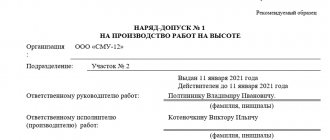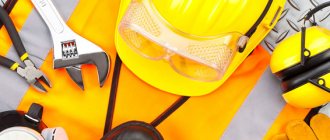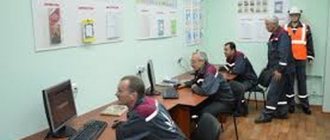A variant of organizing a documentation system describing labor protection at an enterprise. HR department documents. Appointment of a labor protection specialist. Orders and regulations on labor protection. Documents on conducting briefings. Documentation on occupational safety training. Permission to work independently. Internship. Documentation on PPE. Accident investigation materials. Medical examinations. Materials of special assessment of working conditions. Documents reflecting the specifics of the enterprise.
***
Just as there are no two identical enterprises, there are no two identical sets of labor protection documents. We will consider a typical version of organizing a documentation system that describes labor protection at an enterprise. In practice, you can find other options for describing the occupational safety management system.
It must be said right away that local labor safety regulations may even be well written, but they absolutely do not work in practice. On a shelf in a specialist’s office there may be “as it should be”, but the work will be done “as is customary” and the fault for this may be precisely in a thoughtless approach to writing documentation.
HR department documents
Although personnel documents are not directly under the control of a specialist or occupational safety service, they are directly related to our topic. This:
- Organization staffing table;
- Job descriptions of employees;
- Employment contracts;
- Collective agreement;
- Time sheets;
- Internal labor regulations of the organization.
The basic rule in labor protection is that the manager is responsible for his subordinates. Without knowing the structure of the enterprise, without knowing the responsibilities of employees, it is impossible to talk about writing any viable documents on labor protection.
Unfortunately, recently there are more and more recruitment specialists, but fewer and fewer HR specialists. It is no longer uncommon for a boss to be registered in one legal entity, and his subordinates in another legal entity.
Having understood the structure, you need to appoint those responsible with orders.
Storage rules and regulations
New legislation, namely Order of the Ministry of Culture of the Russian Federation No. 558 of August 25, 2010, abolished the need to use the company’s seal in such documents. The presence of the signature of the head of the organization already entails legal force. They store documents from 5 to 75 years, depending on the type.
The labor protection order must not only be accepted, but also observed by employees and management. In the event of a work-related injury by an employee, the persons specified in the document bear liability, including criminal liability, if a death occurs.
*Prices are as of August 2021.
Appointment of a labor protection specialist (OSS)
The appointment of a labor protection specialist and the creation of a labor protection service takes place on the basis of Art. 217 of the Labor Code of the Russian Federation.
In an organization whose number of employees does not exceed 50 people, the tasks of an occupational safety specialist can be performed by its head or an organization that specializes in performing the functions of an occupational safety service and has the appropriate accreditation from the Ministry of Labor.
In organizations with a staff of more than 50 people, the position of a labor protection specialist with appropriate training or experience in this field is introduced.
Download the order for the appointment of a labor protection specialist |
When it is necessary to create a separate service or appoint an OT specialist
In Art. 217 of the Labor Code of the Russian Federation states that an occupational safety service or specialist is appointed only in a production organization with a staff of more than 50 people. But this does not mean that compliance with occupational safety requirements is not monitored at smaller enterprises. After all, the employer is not relieved of the obligation to create safe working conditions, so the manager or individual entrepreneur actually performs the functions of an occupational safety specialist in this case independently.
The manager may decide to create a special service or appoint a person responsible for labor protection even with a smaller number of personnel; this is not prohibited.
When classifying an organization’s activities as production, it is necessary to take into account the clarifications of the Ministry of Labor from letter No. 15-2 / OOG-2136 dated June 10, 2016. In accordance with them, production includes any activity in the process of which goods are created or services are provided. Thus, production, according to the legislator, is not only large complexes or factories.
Occupational Safety and Health Management
- Occupational Safety and Health Policy
A brief document defining the company's policy in the field of organizing work on labor protection. General meaning: The interests of preserving the health of workers are higher than the interests of making a profit.
- Regulations on the labor protection management system
A document describing the occupational safety and health management system. Developed on the basis of order of the Ministry of Labor and Social Protection of the Russian Federation dated August 19, 2021 N 438n
- Occupational safety action plan
A list of activities for the year necessary to comply with the requirements of labor protection legislation, ensure working conditions that meet sanitary standards and prevent injuries.
Occupational safety and health at the enterprise: where to start
The employer's primary actions regarding occupational safety are:
Step 1. Development of Regulations on the occupational safety management system, as well as a policy in the field of occupational safety. Prepare these documents yourself.
For any number of employees, the employer is obliged to ensure not only the development, but also the functioning of the occupational safety management system. This requirement is contained in Article 212 of the Labor Code of the Russian Federation. Therefore, the main document regulating the organization of occupational safety work at an enterprise is the Regulations on the Occupational Safety and Health Management System.
This local regulatory act, mandatory for compliance by the employer and all employees of the enterprise, must stipulate how the powers and responsibilities of the head of the organization, functional managers, and each member of the occupational safety team are distributed.
Also, the Regulations on OHSMS should provide the enterprise policy in the field of labor protection. An important section in the Regulations is the regulations for assessing professional risks. Set real tasks in the Regulations. Include in the provision all sections from Order of the Ministry of Labor of Russia dated August 19, 2016 No. 438n, but adapt it to your organization.
Specify in the regulations on OSHA how to inform workers about labor conditions and safety in the workplace, about the risk of damage to health, the guarantees provided to them, the compensation they are entitled to and personal protective equipment.
In this provision, indicate how the occupational safety management system will be implemented:
- How often and how will department inspections be carried out?
- Which of the managers and specialists will be personally responsible for issuing PPE and washing it?
- responsible for issuing referrals for medical examination and psychiatric examination
- what composition is formed by the commission for conducting the special assessment, etc.
Do not write lengthy phrases from the Internet, write only what is actually achievable. After the OSH regulations have been developed and the Policy has been adopted by management, an order must be issued to approve these documents.
Step 2. Conduct an occupational risk assessment.
Also organize this process yourself; it does not require complex calculations or accreditation and licensing. If you have any difficulties, read our article “ Occupational risks in labor protection: assessment algorithm and ready-made samples ”
Step 3. Purchase only certified and declared personal protective equipment and flushing agents, use machines and equipment, tools and raw materials that have been certified or declared for compliance with technical regulations.
If it seems to you that some workers need not be issued PPE, despite the fact that their profession is indicated in the standard standards, you will have to issue them, but it is allowed to extend their wearing period an unlimited number of times. Such a decision is made by the occupational safety commission, and if there is no such commission, the person responsible for the inspection, appointed by order, can inspect the PPE and make a decision on the percentage of its wear. Don’t forget to train him at the training center, and also improve your skills in inspecting and assessing the quality of personal protective equipment.
★ Standard standards for issuing PPE in 2021
Step 4. Organize timely inspection and maintenance of machinery and equipment, buildings and structures, partial and complete technical inspection, current and major repairs.
Monitor how the managers of workshops and other departments fulfill the schedule of preventive maintenance.
Step 5. Conduct a special assessment at each workplace.
Manage the process yourself, and do not trust management decisions to an expert organization. The special assessment must be completed on the date specified in the contract and no later.
Step 6. Organize training in safe methods and techniques for performing work and providing first aid to victims at work.
Conduct briefings on labor protection , organize on-the-job training and tests of knowledge of labor protection requirements yourself. There is no need to transfer this functionality to the training center.
Send to the training center only the head of the organization, the chief engineer, heads of departments who issue work orders, conduct instructions, are foremen, etc. Do not send the chief accountant or the head of the legal department to the training center unless they provide instructions and are appointed responsible for labor protection. Train them in OT within your organization.
To do this, create a commission of 3-5 people, appoint the head of the organization as its chairman, the chief engineer as its deputy, the labor protection specialist as the secretary, and also include the chief power engineer and the head of the production and technical department. If the enterprise has a trade union or other representative body, appoint its chairman as a member of the commission. The most important thing is that all commission members undergo training at a licensed and accredited training center .
Step 7. Also conduct first aid training in your organization; to do this, prepare your own instructor from among the senior highly qualified employees in the training organization.
He will be given a permanent certificate, equip a training room for him, buy a simulator on which he will teach your workers to perform chest compressions and artificial ventilation. You can't learn this without such a simulator. install first aid stations, place a first aid kit in them, and also provide instructions for use. Be sure to equip a room for first aid - do not confuse it with first aid to victims. The first aid room must be equipped as close to the exit as possible, this will allow the ambulance team to quickly begin providing emergency care upon arrival at your enterprise. No license is required for the employer - after all, assistance will be provided by ambulance workers, and they have the right to perform licensed types of medical care throughout the territory of the subject of the Russian Federation.
Train managers and specialists every three years, and it is better to train workers once a year, along with first aid training. Issue each person a certificate, a sample of which is indicated in the appendix to the Procedure for training and testing knowledge of labor protection requirements No. 1/29 of January 13, 2003. In each occupational safety instruction, in the initial briefing and training programs on occupational safety and health, include questions on how the employee should take measures in the event of such situations, including providing first aid to victims.
Step 8. Answer questions from regulatory authorities in a timely manner, follow all instructions; if any of the occupational safety measures require significant financial investments, contact the State Tax Inspectorate for an extension of the period, and justify such a delay.
Step 9. Form in each division a set of regulatory legal acts containing labor protection requirements in accordance with the specifics of your activity to familiarize workers with labor protection requirements.
Step 10. Carry out all periodic activities on time, submit labor safety reports in a timely manner.
Provisions defining the order of interaction
- Regulations on the labor protection service
Defines the tasks of law, duties and powers of the labor protection service or labor protection specialist.
- Regulations on functional responsibilities
Distributes labor protection responsibilities. (Not to be confused with job responsibilities). The director controls and is responsible, the chief accountant provides financing, managers are responsible for subordinates, etc.
- Regulations on the committee
Defines the tasks of the law, duties and powers of the labor protection committee if it exists in the organization.
Who is responsible?
Occupational Safety Month: order for implementation
The creation of an order can be carried out by authorized employees of the organization who do not hold a high position. For example, these could be secretaries to directors, shop managers or foremen, if this is part of their duties. But only directors or other persons from middle management can be responsible for labor protection. Moreover, they must be specialists in the field represented - undergo appropriate training in order to subsequently provide instructions to employees of the enterprise during their internship or full-time work.
Briefings
Discussed in detail in the chapter “Occupational Safety and Health Instructions”. Documentation includes:
- Regulations on conducting briefings;
- Induction program;
- Instruction on labor protection (IOT) introductory briefing;
- Induction training log;
- Order on the appointment of those responsible for conducting briefings;
- List of those exempt from instruction;
- Initial training programs;
- List of instructions on OT;
- Instructions on labor protection (IOT) for professions and types of work;
- Order to put into effect IOT;
- On-the-job training logs.
Other orders
Of the entire list of possible occupational safety orders that are necessary in an organization, special mention should be made of orders for the appointment of responsible employees called upon to perform certain works. Namely:
- organize work on occupational safety;
- ensure safe work and occupational safety;
- develop safety instructions;
- organize and conduct periodic medical employee examinations;
- provide first aid if an accident or other incident occurs;
- purchase, account for and ensure the issuance of safety shoes, workwear and other personal protective equipment (including neutralizing or flushing agents);
- work of special danger;
- fire safety measures;
- electrical facilities;
- organization and safe performance of high-altitude work;
- organization of loading/unloading and placement of valuables.
The list of functions performed and assignments of officials responsible for occupational safety goes on. It all depends on the specifics of the organization.
Also of great importance are orders on labor protection at the enterprise, which approve instructions for occupational safety of employees and the conduct of briefings for working personnel. They regulate:
- organization of training briefings;
- approval of the material for initial or introductory training;
- Conducting initial and/or introductory briefings directly at the workplace.
If such personnel training activities are carried out and knowledge of occupational safety regulations is tested, in this case the employer issues an order to create an inspection (examination) commission and appoint persons responsible for training the team.
Also see: Civil Defense Briefing from 2 May 2021.
Orders regarding medical examinations:
- about employees undergoing medical examinations;
- on conducting an annual medical examination in a particular year;
- first aid kits;
- approving lists of employees sent for mandatory medical examinations, etc.
The peculiarity of the work of each specific enterprise or organization is the basis for the need for a more complete list of orders.
Also see “Ministry of Labor: logs for recording and issuing instructions on labor protection may not be kept.”
Permission to work. Internship
Employees are allowed to work independently after completing occupational safety training, briefings, medical examinations (if necessary) and on-the-job training.
- Regulations on internship;
- Orders (instructions) on internship;
- Orders for permission to work independently.
We need to be clear here. The essence of the internship is that a new employee works from 2 to 14 shifts “under the supervision” of a more experienced employee. During this time, it is possible to show the employee all the nuances associated with the new workplace. On the other hand, it is possible to see how the qualifications declared by the employee correspond to his ability to work.
In practice, not every employee has the opportunity to complete an internship.
Let's look at an example. We have only one welder in our organization. He quits (retires, goes to the hospital). We are hiring a new employee to replace him. Question. Who should train him? Supervisor? What if he does not have sufficient qualifications?
There are more than one such examples. The essence is important. An internship is a very important element of entry into a position. It is necessary to make a decision on the need in each specific case and conduct an internship on the basis of a specific order (instruction).
General requirements for occupational safety
Every employer is obliged to provide safe working conditions in accordance with the Labor Code of the Russian Federation. Approval of the conditions and requirements for their creation in regulations and orders is a necessary stage of OT. But each organization creates its own list based on the specifics of its activities.
Based on the norms of Section 10 of the Labor Code of the Russian Federation, the basic requirements are established:
- the presence of a responsible occupational safety specialist based on the order;
- carrying out preliminary and periodic medical examinations if necessary;
- identification of harmful and dangerous factors in production, assessment of risks in production;
- production of introductory and periodic briefings on occupational safety;
- special assessment of working conditions;
- providing workers with personal protective equipment and special clothing;
- availability of a training program in occupational safety with the establishment of methods for testing knowledge in the field of labor protection.
In accordance with these requirements and industry standards, documents on labor protection at the enterprise are developed - samples for 2020-2021 can be found here.
The enterprise also needs to monitor changes in legislation in order to promptly make changes to local regulations in accordance with the current edition. The list of regulatory documents on labor protection in 2020-2021 (Labor Code of the Russian Federation, Federal Law-125, Federal Law-426, Resolution of the Ministry of Labor No. 1/29 of 01/13/2003, industry GOSTs, Resolution of the Ministry of Labor of the Russian Federation No. 14 of 02/08/2000) can change.
What are professional standards and why are they needed in education and healthcare?
Individual protection means
Discussed in detail in the section “Protective means”
Protective equipment must be purchased in accordance with the approved list.
list of personal protective equipment |
Also, if necessary, soaps and creams are purchased in accordance with the List of workplaces and the list of employees for whom the issuance of rinsing and neutralizing agents is required.
list of cleaning agents |
All purchased PPE must have certificates or declarations of conformity.
The issuance of personal protective equipment to the employee is confirmed by his personal card for recording the issuance of personal protective equipment.
Download the personal PPE issuance card form |
Local acts
The adoption of orders occurs only in accordance with the notification of the trade union body, which follows from Art. 371 Labor Code of the Russian Federation. An important local act in this case is the Regulations on Labor Safety, which specifies a list of what activities should be carried out by management to familiarize employees with safety measures. The regulation is also approved by order, signed by the head of the company.
Important! All documents are local internal acts, which are registered with the signature of the manager and stored in general documentation.
Documents reflecting the specifics of the enterprise
If the enterprise has special processes or equipment operation, documents reflecting the specifics may be required. Namely:
- Operation of electrical installations;
- Equipment operation;
- High-risk work;
- Loading and unloading operations;
- Hand power tools;
- Metalworking tools;
- Operation of stairs and scaffolds;
- Operation of in-plant transport;
- Operation of vehicles;
- Operation of buildings and structures;
- Operation of elevators;
- Operation of steam and hot water pipelines;
- Operation of pressure vessels;
- Operation of steam and hot water boilers.
etc.
***
Documentation for a special assessment of working conditions must be available in the organization. The procedure for conducting SOUT is discussed in the chapter of the same name.
List of documents on labor protection in the organization for training
To organize training in accordance with legal requirements, an occupational safety specialist will need:
1) Orders on: a) organizing training and knowledge testing in occupational safety; b) exemption from initial and repeated briefings for persons whose work is not related to the maintenance of mechanisms, equipment, etc.; c) creation of a commission (commissions) for testing knowledge;
2) Regulations on: • training and testing of knowledge in occupational safety;
3) Training programs with test questions for: • engineers; • each working profession; • by type of work;
4) Protocols for testing knowledge of labor protection requirements;
5) Instruction programs: introductory and conducted by work managers;
6) Log books: • briefings – introductory and conducted by work managers. They are usually kept by the persons who conduct them; • assignment of 1st electrical safety group to workers who are not electrical personnel.
There should be and actively use stands, posters, and safety signs.









